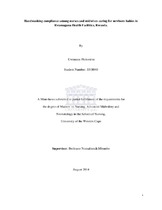| dc.contributor.advisor | Mbombo, Nomafrench | |
| dc.contributor.author | Philomène, Uwimana | |
| dc.date.accessioned | 2015-05-19T14:33:12Z | |
| dc.date.available | 2015-05-19T14:33:12Z | |
| dc.date.issued | 2014 | |
| dc.identifier.uri | http://hdl.handle.net/11394/4145 | |
| dc.description | Magister Curationis - MCur | en_US |
| dc.description.abstract | Infections (including healthcare-associated infections) are one of the leading causes of neonatal morbidity and mortality, yet these deaths could be prevented by cost-effective interventions. Handwashing (HW) is crucial to preventing the spread of antimicrobial resistance and reducing healthcare-associated infections (HCAIs). However, healthcare workers' compliance with optimal practices remains low in most settings.The purpose of this study was to determine the compliance with HW among nurses and midwives caring for newborn babies at Rwamagana Health Facilities, and the extent to which demographic and cognitive characteristics predict nurses' HW compliance. The study’s methodology involved a cross-sectional approach encompassing descriptive and quantitative methods. The data was collected over a period of 3 weeks from a total sample of 139 nursemidwives. An anonymous self-administered questionnaire was used to collect data; out of 139 questionnaires distributed 134 were returned back completed, giving a rate of 96.4%. The data analysis was done using SPSS software version 21.The results demonstrate that a mean self-reported HW compliance rate was 82.00% (SD= 13.60). A compliance rate of 80% or greater was confirmed by most of the participants in the study (79.1%). The highest reported rate of hand washing was HW after exposure to the newborn's body fluids (M= 89.33%; SD= 14.878),while results revealed that nurses tend to perform less HW after touching an object in the vicinity of the patient(73.43%; SD=22.81). A multiple regression analysis revealed that attitudes, subjective norms and intentions were unique independent predictors of HW compliance. However, results did not show any relationship between HW and nurses' demographic characteristics.This study recommends that, strategies aiming to improve HW compliance must be focused on concepts that predict HW. Further research ought to be conducted using observational approach. | en_US |
| dc.language.iso | en | en_US |
| dc.publisher | University of the Western Cape | en_US |
| dc.subject | Midwife | en_US |
| dc.subject | Newborn | en_US |
| dc.subject | Healthcare associated infections | en_US |
| dc.title | Handwashing compliance among nurses and midwives caring for newborn babies in Rwamagana health facilities, Rwanda | en_US |
| dc.type | Thesis | en_US |
| dc.rights.holder | University of the Western Cape | en_US |

